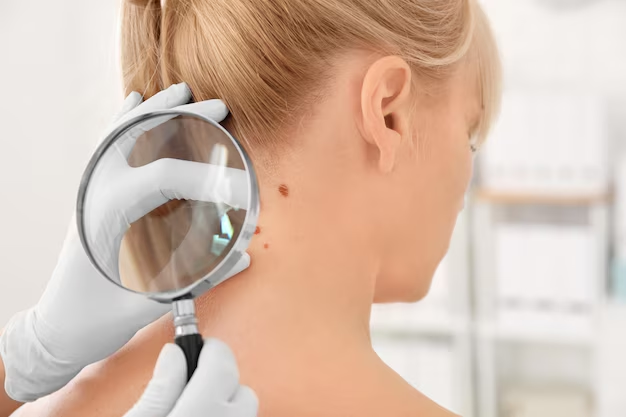Recognizing Skin Cancer: What You Need to Know
Imagine you're scanning your skin in front of a mirror, checking for any irregularities you might have missed last time. For many, this is a routine part of self-care; however, not everyone knows precisely what to look for. Identifying skin cancer can be challenging, especially when its appearance varies so widely. Learning to differentiate between harmless spots and those warranting further investigation is key to early detection.
What Exactly is Skin Cancer?
Skin cancer is the abnormal growth of skin cells, often developing on skin exposed to the sun. However, it can also occur on areas not ordinarily exposed. Understanding its types is crucial as they each present differently.
The Main Types of Skin Cancer
Basal Cell Carcinoma (BCC)
- Most common and often appears as a slightly transparent bump on the skin.
- Potentially misleading due to its resemblance to common skin issues.
Squamous Cell Carcinoma (SCC)
- Tends to appear as a hard lump with a scaly, crusty top.
- Can resemble warts or an open sore.
Melanoma
- The most aggressive type but less common.
- Characterized by a new, unusual-looking mole or a change in an existing mole.
How to Identify Skin Cancer
Recognizing skin cancer's different forms is vital for early detection and treatment. Here's a detailed look at indicators for each type.
Basal Cell Carcinoma (BCC) Characteristics
- Appearance: Often appears as a pearly white, skin-colored, or pink bump that is translucent, meaning you can often see through to some subtle blood vessels beneath.
- Texture: Can be a flat, scaly patch on the trunk or a sore that heals then reopens.
- Location: Frequently found on sun-exposed areas such as the face, ears, neck, scalp, shoulders, and back.
Identifying Squamous Cell Carcinoma (SCC)
- Look for: A firm, red nodule, or a flat lesion with a scaly, crusted surface.
- Common Areas: Typically arises on the ears, face, hands, neck, or lips.
- Warning Signs: Rapid growth, a hard mass, or ulceration that persists.
Spotting Melanoma
- The ABCDE Rule:
- Asymmetry: One half of the mole doesn’t match the other.
- Border: Edges that are irregular, ragged, or blurred.
- Color: Variety of colors within a single mole.
- Diameter: Larger than 6 mm (about the size of a pencil eraser).
- Evolving: Any change in size, shape, color, or elevation.
Skin Cancer Across Skin Tones
The presentation can vary significantly based on skin tone. Awareness of these variations ensures inclusivity in self-examinations.
- Fair Skin: More prone to early detection due to contrast, but also more susceptible to damage.
- Darker Skin: Cancers may occur on non-exposed areas like palms and soles; hence, regular examination of these areas is critical.
Precautionary Measures: What to Do
Actively engaging in skin cancer prevention and early detection strategies can make a significant difference.
Regular Self-Examinations
- Monthly Checks: Perform these in a well-lit room using both full-length and hand-held mirrors to examine all areas.
- Partner Help: A family member or partner can assist with hard-to-see areas like the back and scalp.
Professional Skin Checks
- Dermatologist Visits: Routine screenings, especially for individuals with high risk or previous skin cancer history, can provide an added layer of assurance.
Sun Safety Tips
- Sunscreen: Use broad-spectrum sunscreen with at least SPF 30.
- Protective Clothing: Wear long-sleeve shirts, pants, and hats when outside.
- Seek Shade: Limit exposure during peak sun hours (10 a.m. to 4 p.m.).
- Avoid Tanning Beds: A significant risk factor for developing skin cancer.
Debunking Myths About Skin Cancer
Dispelling common misconceptions aids in better understanding and prevention.
Myth 1: Dark-skinned individuals don’t get skin cancer.
- Reality: While less common, it does occur and can be more aggressive if not detected early.
Myth 2: Only new moles can indicate melanoma.
- Reality: Existing moles can change and become cancerous.
Myth 3: Skin cancer only develops in sunny climates.
- Reality: Can occur anywhere and anytime, as UV radiation can penetrate clouds and reflect off surfaces like snow.
Empowering With Knowledge: Know When to See a Doctor
Actions to consider if you notice atypical changes:
- Persistent Changes: Consistent change in the skin’s appearance signals the need for further evaluation.
- Lesions That Don’t Heal: A sore that doesn’t heal within a month should be examined.
- Rapid Growths or Painful Lesions: Immediate assessment is advised.
Recognizing and understanding skin cancer’s indicators is an essential step in maintaining skin health. While this knowledge equips you with the ability to spot potential issues, remembering regular dermatological check-ups remains imperative.
Skin Cancer Quick Reference Guide 📝
- Look for: Asymmetrical spots, irregular borders, multiple colors, or changes in size/shape 📏
- Self-check: Once a month; involve a partner for hard-to-see areas 🪞
- Sun Safety: Use sunscreen SPF 30+, cover up, and seek shade ☂️
- Myths: Anyone can get skin cancer, changes in old moles matter, and it can strike in any climate 🌍
- Consultation: Seek professional advice for persistent or unusual skin changes 👩⚕️
By arming yourself with knowledge and staying vigilant, you actively contribute to your skin’s health and well-being. 🛡️

Related Articles
- Are Breast Cancer Lumps Painful
- Are Chills a Sign Of Cancer
- Are Colon Spasms a Sign Of Cancer
- Are Lytic Lesions Always Cancer
- Are Polyps Cancer
- Can a Blood Test Detect Cancer
- Can a Ct Scan Detect Cancer
- Can a Dexa Scan Show Cancer
- Can a Gastric Emptying Scan Show Cancer
- Can a Lung Biopsy Cause Cancer To Spread